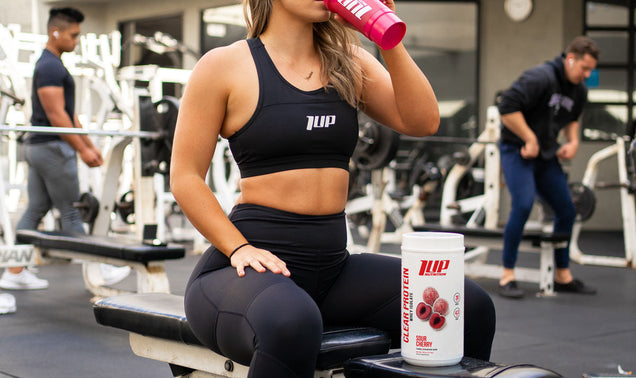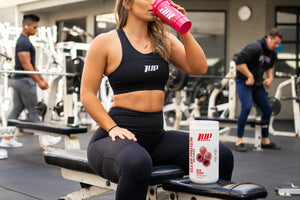Knowing how many calories you need to eat to lose weight or build muscle is paramount to seeing results in your transformation challenge.
One of the biggest components in determining how many calories you need to eat to lose weight or build muscle is your resting metabolic rate (RMR).
Frequently, you’ll see the terms resting metabolic rate and basal metabolic rate (BMR) used interchangeably.
But, are they the same thing?
In this article we’ll discuss precisely that as well as touch on a few of the other factors that affect the number of calories you burn each day (also known as your total daily energy expenditure -- TDEE).
What is Resting Metabolic Rate (RMR)?
Resting metabolic rate (RMR) is a measure of how many calories your body burns at rest.
In other words, resting metabolic rate is the energy your body expends just to keep you alive if all you did during the day was lay in bed and blink your eyes, breathe, and sleep. Resting metabolic rate does NOT include movement or the energy used to digest and absorb food (which is known as the thermic effect of feeding -- TEF).
Resting metabolic rate is only the amount of energy to sustain life absent movement or nutrient digestion and absorption.
It includes the energy (calories) consumed by the brain, heart, and other organs needed to sustain life.
You might also be interested to know that your resting metabolic rate constitutes the largest component of your total daily energy expenditure (TDEE).
Now, let’s discuss the differences between resting metabolic rate and basal metabolic rate (BMR).
RMR vs BMR
Most individuals use the acronyms RMR and BMR interchangeably. And, on the surface they are pretty much the same as both represent the number of calories an individual burns in a rested and fasted state.
However, there is a subtle distinction between the two, and it comes in the way (or more appropriately time) each is measured.
BMR measurements are taken shortly after waking, following an overnight fast in a research facility or metabolic ward, which limits the amount of movement prior to measurement.[1,2]
RMR is also measured following an overnight fast. However, individuals having their BMR measured usually didn’t spend the night at the research facility or metabolic ward. They slept at home and then drove to the facility after waking.
As a result, RMR is slightly higher than BMR due to the low level of activity participants have completed (rolling out of bed, walking to the car, etc.) prior to arriving at the testing facility.
Is RMR or BMR Better?
Neither RMR or BMR is “better.”
BMR can be thought of as slightly “better” since it is conducted immediately after waking in a research facility, but both RMR and BMR are viewed by the scientific community as viable options when determining an individual’s energy needs.
A number of equations have been developed to help individuals estimate their RMR, but the “gold standard” for measuring RMR or BMR is via gas analysis.
Unfortunately, most people either don’t own the machine that performs this as it is incredibly expensive, not to mention hard to find. The only places that typically provide gas analysis are metabolic wards and research facilities.
Due to this, metabolism researchers have developed various models (equations) to help fitness enthusiasts estimate their energy needs at rest.
It’s important to note that all metabolic equations used to calculate TDEE, RMR, BMR, etc are estimates at best. They are not 100% accurate and can vary wildly depending on which equation you use.
In fact, a 2013 study compared various RMR equations against a research-measured RMR, and found that RMR equations overestimated energy expenditure between 5.5-17%.[1]
As such, any time you are using an online calorie calculator, understand that it usually tends to be on the high side.
What Factors Affect RMR?
Resting metabolic rate is affected by a wide variety of factors including:
- Age
- Sex
- Weight
- Genetics
- Body composition (muscle to fat ratio)
- Smoking status
- Menstrual cycle
The use of certain dietary supplements can impact resting energy expenditure.
Caffeine, for instance, has been shown to modestly boost daily energy expenditure up to 150 calories per day in lean individuals.[4]
As we mentioned above, body weight also affects RMR, and as you lose weight (hopefully body fat), RMR (as well as BMR) can decrease as well (a phenomenon known as metabolic adaptation).
Due to this “downshifting” of metabolic rate, it’s important that you reassess your calorie needs every few weeks during your transformation challenge, to ensure that you’re still placing your body in a calorie deficit.
What to Do Next?
RMR/BMR is just one component of the total amount of energy your body burns in a day.
Consider it the “foundation” of your metabolism and daily calorie needs.
Once you have this estimate, you then need to factor in how many calories you burn during:
- Exercise
- Non-exercise activity (blinking, walking from one room to another, washing dishes, etc.)
- Eating and digesting.
Fortunately, you don’t have to perform separate calculations in order to estimate how many calories you need to eat each day to lose weight.
Researchers have developed a number of different models to help active individuals estimate their calorie needs.
Click here if you’re interested in figuring out your TDEE today!
Now, it’s important to note that your TDEE is the estimated (approximate) number of calories you need to maintain your weight.
If you want to lose weight (body fat), then you need to eat fewer calories than your TDEE.
If you want to gain weight and build muscle, then you need to consume more calories than your TDEE.
Takeaway
At the end of the day, both RMR and BMR measure how much energy your body burns at rest.
There are slight differences between the two, but those differences are minimal.
RMR/BMR are the largest component of your total daily energy expenditure (TDEE).
It’s affected by a multitude of factors, inlcuding your age, weight, sex, and body composition.
A number of equations have been developed to help individuals estimate their RMR and TDEE, which can be helpful if you’re trying to lose weight, build muscle, or maintain your results.
References
- Miller S, Milliron BJ, Woolf K. Common Prediction Equations Overestimate Measured Resting Metabolic Rate in Young Hispanic Women. Top Clin Nutr. 2013;28(2):120–135. doi:10.1097/TIN.0b013e31828d7a1b
- Frankenfield D, Roth-Yousey L, Compher C. Comparison of predictive equations for resting metabolic rate in healthy nonobese and obese adults: a systematic review. J Am Diet Assoc. 2005;105(5):775–789.
- Speakman, J. R., & Selman, C. (2003). Physical activity and resting metabolic rate. The Proceedings of the Nutrition Society, 62(3), 621–634. https://doi.org/10.1079/PNS2003282
- Dulloo, A. G., Geissler, C. A., Horton, T., Collins, A., & Miller, D. S. (1989). Normal caffeine consumption: influence on thermogenesis and daily energy expenditure in lean and postobese human volunteers. The American Journal of Clinical Nutrition, 49(1), 44–50. https://doi.org/10.1093/ajcn/49.1.44






